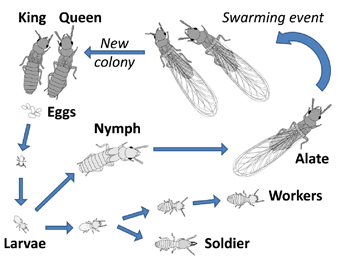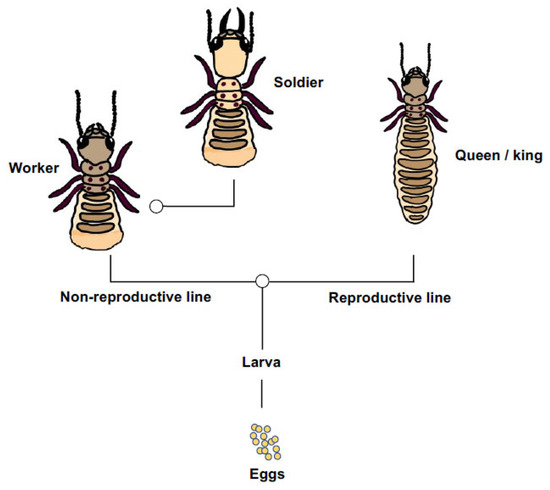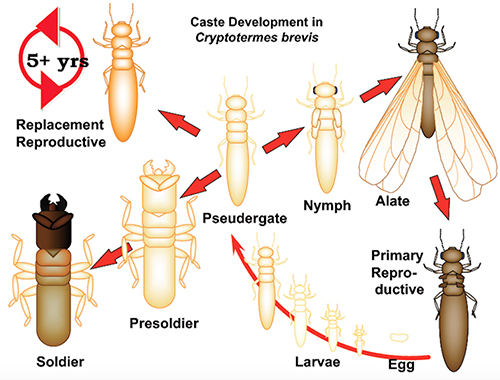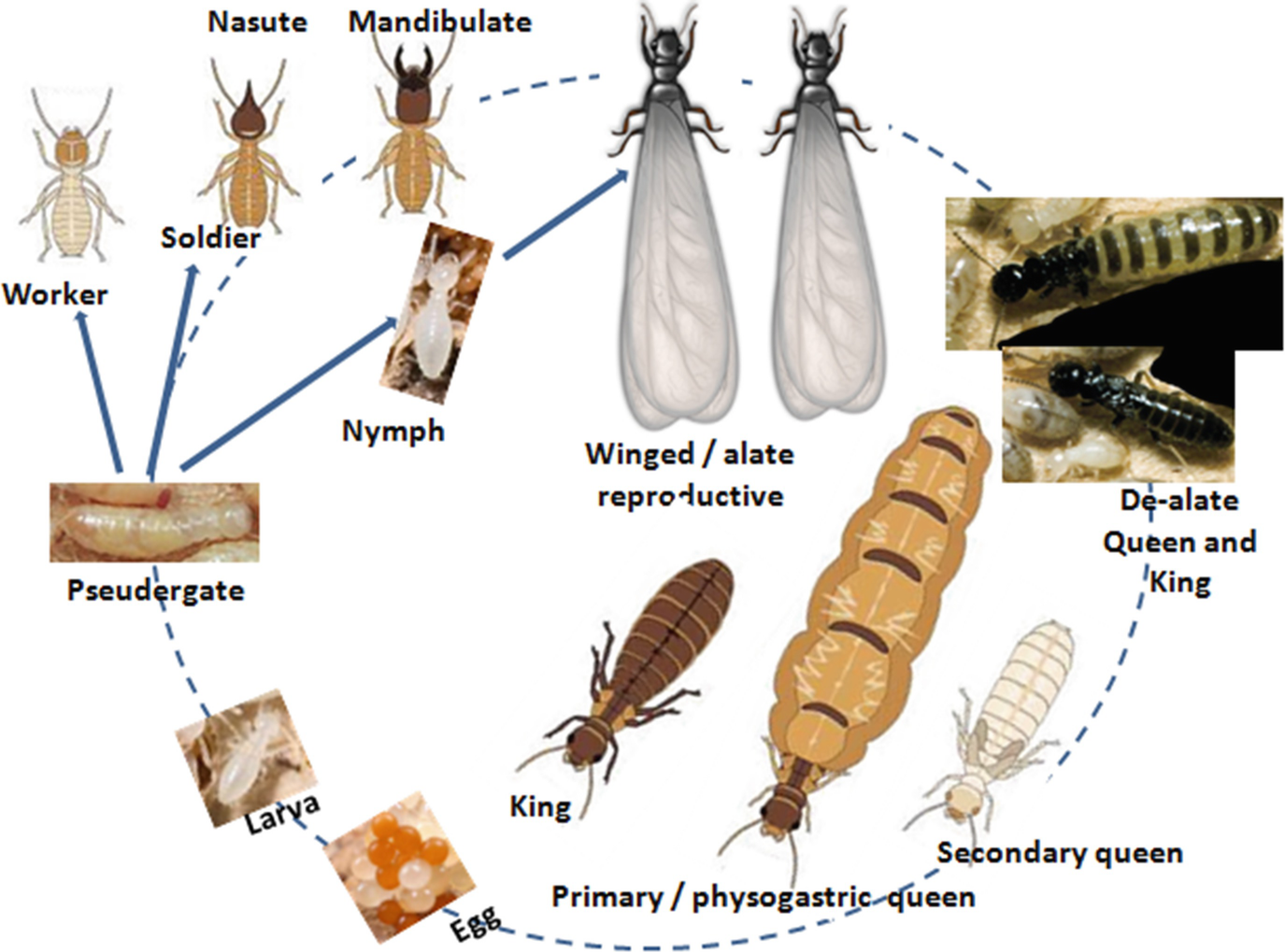termite life cycle pdf
The queen lays eggs which develop into larvae and then worker or soldiers. Types of individuals make up the termite caste system.

Life Cycle Of Termites Termites Life Cycles Termite Control
Formosan a and b drywood c and desert d termites.

. Life cycle Like ants and bees termites are social insects that form colonies Fig. Typical subterranean termite life cycle. Subterranean termites live in the soil while dry-oodtermites live in sound dry w above level.
Termites have protozoa in their digestive tracts that can convert cellulose into usable food so subterranean termites feed on items that contain. Workers soldiers and reproductives which may or may not be winged. It is white and has an oval shape.
The egg of a termite is very small. They need no contact with soil the wood they digest provides moisture needed to survive. Within these castes are a complex life cycle with the development of individuals that look and behave differently from other members of the group.
The simplified model of a termite life cycle indicates the three castes the reproductives the soldiers and the workersDue to the fact that termites are hemimetabolous insects even the nymphs take part in the social life and have their specific tasks to fulfil. 1 The Egg Stage 1 After fertilization the female termite lays her eggs in a jelly-like liquid that holds the eggs together. Soldier top with enlarged head and mandibles and worker termites.
Ad Do-It-Yourself Save. The queen can lay from several 100 to several 1000 every day. Winged adult termite.
Life Cycle of Termite. The termite eggs can also be described as translucent or light brown in color. The life cycle of a termite starts with a fertilized egg.
Termites begin life as eggs produced by the king and queen of the colony. The eggs undergo 4 moltings molting is nothing but development and after the combination of these moultings it. A female termite can lay around 30000 eggs in one day.
Termites have microorganisms in their intestines to help digesting the cellulose. Termites live in true social groups with a division of labor between the different castes of individuals. An infestation begins when a mated pair finds a suitable nesting.
As time passes she will become more prolific and produce about 60 eggs per day fig. Stage 1 Termite Egg Like most insects termites begin at the egg stage. The Eastern Subterranean Termite queen initially produces about 20 eggs.
The very first eggs laid by the queen termite are usually yellow in color no matter the termite species. The different castes are separated into adult reproductives workers and soldiers. Termite eggs are small and white in colour and can be noticed through the naked eye.
Nymphs may develop into any of three kinds of adult termites soldiers workers or reproductives. During swarming events male and female alates are produced from mature colonies. Although there are over 2000 different species of termites they all pretty much have the same life cycle 6 stage cycle.
Termites continue to mate for life unlike ants that mate only once. They may follow roots or abandoned tunnels previously excavated by ants or earthworms. New kings and queens are winged during their early adult life but lose their wings after dispersing from their origi-nal colony.
Soldiers have extra large helmet-like heads used to defend the colony. Formosan subterranean termite life cycle. Termites are social insects that form large colonies.
LIFE CYCLE Most termite species swarm in late summer or fall although spring swarms are not uncommon for subter-ranean and drywood termites. Termite life cycle comprises of eggs immature forms or nymphs and mature forms or adults which include sterile workers soldiers pseudergates and various fertile winged or. For the termite life cycle.
This is nothing when compared with the tropical mound building termite Odontotermes obesus. Head of drywood swarmer No fontanelle Clypeus not divided Divided clypeus Fontanelle Head of formosan swarmer Forewing of drywood termite Forewing of formosan termite Three or more veins at front margin. Free Shipping Expert Advice.
When searching for food termites usually follow a chemi-cal or moisture gradient toward the food source. Once food source is found more termites will be sent to feed on the food. The queen of this termite species.
Communication in the Colony Termites in the same colony communicate with. Needs of the colony and by the termite life cycle. The termites eggs usually take about a duration of 30 days in order for it to hatch into larvae.
The eggs hatch to become nymphs which are immature termites. A pair of reproduc-tive termites called a female or queen and a. 1 single queen can lay up to 10 million eggs in her lifetime and she can found up to 20 different colonies in her lifetime.
Basically worker termites travel away from the nest to search for food and building tunnels while they are foraging. A male and a female pair from such swarms drop their wings dealates and found a new colony to become king and queen.

Termite Life Cycle Termites Termite Control Termite Extermination

Drywood Termites Extension Entomology

Wood Preservation Wood Destroying Organisms Kentucky Pesticide Safety Education

Insects Free Full Text Differential Selection On Caste Associated Genes In A Subterranean Termite Html

West Indian Powderpost Drywood Termite Cryptotermes Brevis Walker

Subterranean Termites Extension Entomology

Pdf Subterranean Termites Their Prevention And Control In Buildings Semantic Scholar
